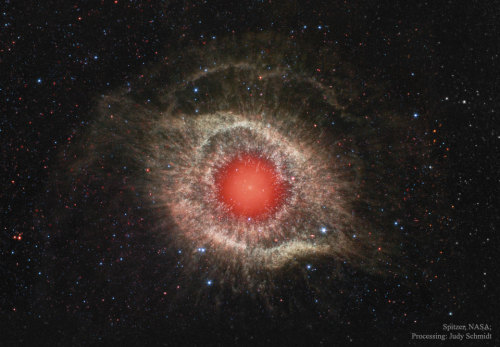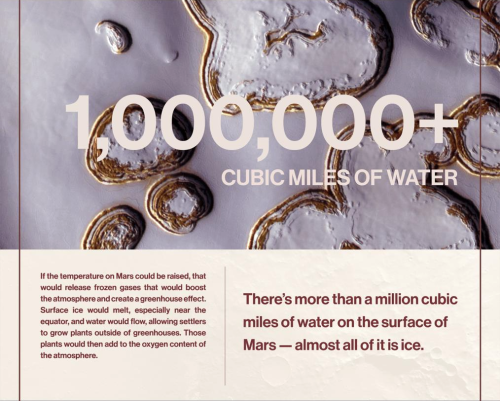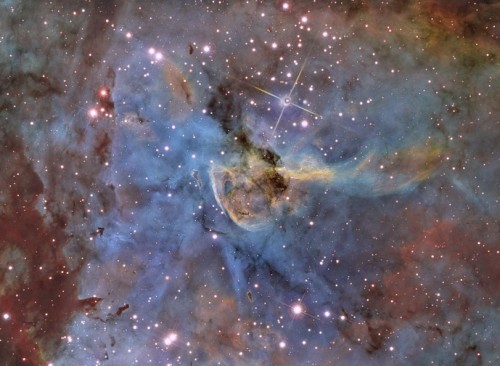Helix Nebula // NGC 7293

Helix Nebula // NGC 7293
More Posts from Samstein1012 and Others

ABRACADABRA (A Broadband/Resonant Approach to Cosmic Axion Detection with an Amplifying B-field Ring Apparatus), consists of a series of magnetic coils, wound in the shape of a toroid, or donut, which is then encased in a layer of superconducting metal and kept at temperatures just above absolute zero. The scientists plan to use a highly sensitive magnetometer, placed inside the donut hole, to detect any signs of axions’ influence. MIT physicists are proposing a new experiment to detect a dark matter particle called the axion. If successful, the effort could crack one of the most perplexing unsolved mysteries in particle physics, as well as finally yield a glimpse of dark matter. Axions are hypothetical elementary particles that are thought to be among the lightest particles in the universe — about one-quintillionth the size of a proton. These ultralight particles are virtually invisible, yet if they exist, axions and other yet-unobserved particles may make up 80 percent of the material in the universe, in the form of dark matter. In a paper published online in Physical Review Letters, the MIT team proposes an experiment to detect axions by simulating an extreme astrophysical phenomenon known as a magnetar — a type of neutron star that generates an immensely powerful magnetic field. The physicists reasoned that in the presence of an axion such a huge magnetic field should waver ever so slightly, producing a second, vastly smaller magnetic field as a signature of the axion itself. The team consists of MIT associate professor of physics Jesse Thaler, MIT Pappalardo Fellow Benjamin Safdi, and Yonatan Kahn PhD ’15, now a postdoc at Princeton University. Together, they designed an experiment to recreate the physics of a magnetar in a controlled laboratory environment, using technology borrowed from magnetic resonance imaging (MRI). The core of the experiment, which they’ve named ABRACADABRA (A Broadband/Resonant Approach to Cosmic Axion Detection with an Amplifying B-field Ring Apparatus), consists of a series of magnetic coils, wound in the shape of a toroid, or donut, which is then encased in a layer of superconducting metal and kept in a refrigerator at temperatures just above absolute zero, to minimize external noise. The scientists plan to use a highly sensitive magnetometer, placed inside the donut hole, to detect any signs of axions’ influence. “Axions are very strange, counterintuitive particles,” Thaler says. “They’re extremely light, with feeble interactions, and yet this particle may dominate the matter budget of the universe and be five times more abundant by mass than ordinary matter. So we really had to think hard on whether these particles are in principle detectable using current technology. It’s extremely daunting.” A “tantalizing” particle If they are detected, axions may also explain an outstanding dilemma in particle physics, known as the Strong CP (charge parity) problem: Since the 1970s, scientists have grown increasingly puzzled over what Safdi describes as “the indifference of neutrons to electric fields.” Neutrons are elementary particles that are found in the nucleus of almost every atom in matter, and they do not carry a net charge. “We don’t expect neutrons to accelerate in the presence of an electric field because they don’t carry electric charge, but you might expect them to rotate,” Safdi says. “That’s because we expect them to have an electric dipole moment, where you can think of a neutron having a plus charge on one side and a minus charge on the other. But from our current understanding, this rotation effect does not exist, whereas theory says it should.” Scientists have hypothesized that this bizarre effect may be explained by the axion, which would somehow remove a neutron’s electric dipole moment. If so, the axion would modify electric and magnetic phenomena in a way that could be detectable experimentally. “It’s very tantalizing to say there might be a particle that serves this deep purpose, and even more so if we were to detect the presence of these particles in the form of dark matter,” Thaler says. The hunt is on Currently, Thaler says most axion hunting has been carried out by researchers at the University of Washington who are running the Axion Dark Matter Experiment, or ADMX. The experiment uses a resonant microwave cavity, set within a large superconducting magnet, to detect very weak conversions of axions to microwave photons. The experiment is tuned to look for axions within a specific range of around one quadrillionth the mass of a proton. Thaler and his team realized that they could extend this range, and look for much smaller, lighter particles, on the order of one quintillionth the mass of a proton, by recreating the physics of magnetars, in the lab. “The Strong CP problem is associated with whether a neutron’s spin responds to electric effects, and you can kind of think of a magnetar as one gigantic spin with big magnetic fields,” Thaler explains. “If axions are coming in and changing the properties of nuclear matter to resolve the Strong CP problem, maybe axions can interact with this magnetar and allow you to see it in a new way. So the subtle effects of axions should be amplified.” The team’s prototype design is surprisingly small — “about the palm of your hand,” Safdi says. The researchers, who are theoretical physicists by training, are now working with experimentalists at MIT to build the prototype, which is designed to generate a baseline magnetic field of about 1 tesla, comparable to current MRI machines. If axions are present, that field should waver slightly, producing a very tiny oscillation at a frequency that is directly related to the axion’s mass. Using a high-precision magnetometer, Thaler hopes to pick up that frequency and ultimately use it to identify the axion’s size. “Only recently have there been many good ideas to search for [low-frequency axions],” says Gray Rybka, an assistant professor of physics at the University of Washington and an ADMX researcher, who was not involved in the research. “The experiment proposed here builds on previous ideas and, if the authors are correct, may be the most practical experimental configuration that can explore some of the plausible lower-frequency axion regimes.” “We have an instrument that’s sensitive to many wavelengths, and we can tickle it with an axion of one particular wavelength, and ABRACADABRA will resonate,” Thaler says. “And we will be going into uncharted territory, where we could possibly see dark matter from this prototype. That would be amazing.” This research was supported, in part, by the U.S. Department of Energy and the Alfred P. Sloan Foundation.






Life on Mars





For more on the Fermi Paradox and why alien life hasn’t found us yet. (Infographic via futurism)

What strange world is this? Earth. In the foreground of the featured image are thePinnacles, unusual rock spires in Nambung National Park in Western Australia. Made of ancient sea shells (limestone), how these human-sizedpicturesque spires formed remains unknown. In the background, just past the end of the central Pinnacle, is a bright crescent Moon. The eerie glow around the Moon is mostly zodiacal light, sunlight reflected by dust grains orbiting between the planets in the Solar System. Arching across the top is the central band of our Milky Way Galaxy. Many famous stars and nebula are also visible in the background night sky. The featured 29-panel panorama was taken and composed last September after detailed planning that involved the Moon, the rock spires, and their corresponding shadows. Even so, the strong zodiacal light was a pleasant surprise. Image Credit: Michael Goh
We have been expecting you Mr Handle......



Is Proxima b another Earth? It’s difficult to answer because no one has actually “seen” this distant planet which orbits the red dwarf star Proxima Centauri right in theGoldilocks Zone. Scientists have merely concluded that Proxima b (which is about 4.2 light years away from Earth) is right where it should be, by observing the regular, subtle changes in Proxima Centauri’s color. Proxima b is tidally locked to its star — which means one side of it is always facing Proxima Centauri, and the other side is perpetually dark. With just an 11.2-year revolution, it lies very close to its star, although red-dwarf stars are not as hot as yellow-dwarves (like our Sun). There is a possibility that water exists on Proxima b, and that it has an atmosphere protecting it from extreme heat, and scattering heat even to its dark side. How can we be sure? Harvard’s Avi Loeb and astronomer Laura Kreidberg propose that we use NASA’s James Webb Space Telescope (JWST). UNCERTAINTIES The long-delayed JWST is set to launch by 2018 (originally 2011). Loeb explains that if a rocky planet, like Proxima b, has an atmosphere, it would absorb light from its star and re-emit it as infrared light. Incidentally, the JWST is specifically designed to observe infrared light. The JWST can take photos of infrared light on the surface Proxima b, looking for patterns that would confirm whether or not this exoplanet has water or is covered by an atmosphere. Things aren’t so simple, however. The proposed method may be doable. But there are other factors that have to be considered. For instance, the existence of an atmosphere may not guarantee life, says astrophysicist Ed Turner of Princeton University. Proxima b may be like Venus, with an atmosphere 90 times thicker than ours, and extreme heat. Still, Loeb’s and Kriedberg’s plan is the only option we have for a glimmer of an answer about this “Earth next-door”. References: Business Insider, Scientific American
6 Ways Earth Observations Tackle Real-World Problems
This summer, 30 research projects were launched by recent college graduates and early career professionals as part of our DEVELOP program. The aim is to use our satellite observations of Earth to address an environmental or public policy issue. And they have just 10 weeks to do it! On Aug. 10, 2016, the “DEVELOPers” gathered at our Headquarters in Washington, DC to showcase their results. So, how can Earth observations solve real-world problems? Let’s take a look:

1. They help land managers identify the locations of invasive species.
Austin Haney, DEVELOP project co-lead at University of Georgia, has seen first-hand how an invasive species can affect the ecosystem of Lake Thurmond, a large reservoir that straddles the border between Georgia and South Carolina. Birds in the area “behave visibly different,” he said, after they consume a toxic cyanobacteria that lives on Hydrilla verticillata, an invasive aquatic plant. Ingesting the toxin causes a neurodegenerative disease and ultimately death. Scores of birds have been found dead near lake areas where large amounts of the toxin-supporting Hydrilla grow. To help lake managers better address the situation, Haney and project members developed a tool that uses data from the Landsat 8 satellite to map the distribution of Hydrilla across the lake.
Image Credit: NASA/Bill Ingalls

2. They help identify wildlife habitat threatened by wildfires.
Maps that depict habitat and fire risk in eastern Idaho previously stopped short of Craters of the Moon National Monument and Preserve, where shrubs and grasses transition to a sea of ankle-twisting basalt. But the environment is not as inhospitable as it first appears. Throughout the monument there are more than 500 kipukas —pockets of older lava capable of supporting some vegetation. That means it is also prone to burning. Project lead Courtney Ohr explained how her team used data from the Landsat 8 and Sentinel-2 satellites to develop a model that can simulate the area’s susceptibility to wildfires. Decision makers can use this model to monitor the remote wildlife habitat from afar.
Image Credit: NASA/Bill Ingalls

3. In conjunction with Instagram, they help find seaweed blooms
Who knew that Instagram could be a tool for science? One DEVELOP team searched for photographs of massive seaweed (sargassum) blooms in the Caribbean, mapped the locations, and then checked what satellites could see. In the process, they tested two techniques for finding algae and floating vegetation in the ocean.
Image Credit: Caribbean Oceans Team

4. They help conserve water by reducing urban stormwater runoff.
Atlanta’s sewer system is among the nation’s most expensive. Yet, the city still struggles with stormwater. It’s an uphill climb as new construction paves over more of the city, hindering its ability to absorb rain. The University of Georgia DEVELOP team partnered with The Nature Conservancy to address the problem.
Using satellite imagery, the team was able to pinpoint areas well-poised to capture more of the city’s runoff. They identified 17 communities ripe for expanding green infrastructure and reforestation. The team used the Land-Use Conflict Identification Strategy and Soil and Water Assessment Tool models and Landsat and Terra satellite data. Their analysis provides local groups with a working picture of the city’s water resources.
Image Credit: NASA/Bill Ingalls

5. They show the spread of the mite eating away Puerto Rico’s palm trees.
The red palm mite has devastated Puerto Rico’s trees in recent years. The insect chewed its way through coconut palms, bananas, and plantains on the island in the recent decade. Its spread has hurt crops across the Caribbean.
A DEVELOP team led by Sara Lubkin analyzed satellite imagery to track the mites’ rapid spread from 2002. The team mapped changes to vegetation, such as yellowing, and differences in canopy structure. They made use of imagery from Landsat, Hyperion, IKONOS, and aerial views. Their work can be used to mitigate current mite infestations and monitor and prevent future ones.
Image Credit: NASA/Bill Ingalls

6. They evaluate landslide-prone areas in the developing world
One team of DEVELOPers took on several projects to aid people in developing nations. This team from Alabama examined satellite imagery to find past landslides in the African nation of Malawi. Factors such as flooding after long periods of drought have made the country increasingly prone to landslides. Blending maps of the landscape, rainfall data, and population centers, the young researchers assessed the areas most at risk—and most in need of education and support—from landslides.
Image Credit: East Africa Disasters II Team
Want to read more about DEVELOP projects, or get involved? Summaries, images, and maps of current and past projects can be viewed HERE. You can also learn how to apply for the DEVELOP program HERE.
Make sure to follow us on Tumblr for your regular dose of space: http://nasa.tumblr.com
-
 donutsandpancakes liked this · 2 weeks ago
donutsandpancakes liked this · 2 weeks ago -
 lexiandandromeda liked this · 10 months ago
lexiandandromeda liked this · 10 months ago -
 waiting-for-youuu reblogged this · 11 months ago
waiting-for-youuu reblogged this · 11 months ago -
 phil-the-destroyer-of-worlds liked this · 1 year ago
phil-the-destroyer-of-worlds liked this · 1 year ago -
 arfeustortal liked this · 1 year ago
arfeustortal liked this · 1 year ago -
 martinpalermo liked this · 2 years ago
martinpalermo liked this · 2 years ago -
 laviejasapa reblogged this · 2 years ago
laviejasapa reblogged this · 2 years ago -
 laviejasapa liked this · 2 years ago
laviejasapa liked this · 2 years ago -
 meetszn liked this · 2 years ago
meetszn liked this · 2 years ago -
 foulphantomfury reblogged this · 3 years ago
foulphantomfury reblogged this · 3 years ago -
 animatempestas reblogged this · 3 years ago
animatempestas reblogged this · 3 years ago -
 celestialaxia reblogged this · 3 years ago
celestialaxia reblogged this · 3 years ago -
 bettito12 liked this · 3 years ago
bettito12 liked this · 3 years ago -
 interpretating0 liked this · 3 years ago
interpretating0 liked this · 3 years ago -
 bodhiblue reblogged this · 3 years ago
bodhiblue reblogged this · 3 years ago -
 kishikutokuarikutazufu liked this · 3 years ago
kishikutokuarikutazufu liked this · 3 years ago -
 badgalkeyaa-blog reblogged this · 3 years ago
badgalkeyaa-blog reblogged this · 3 years ago -
 keven-mikael reblogged this · 3 years ago
keven-mikael reblogged this · 3 years ago -
 monaluun liked this · 3 years ago
monaluun liked this · 3 years ago -
 ekax liked this · 3 years ago
ekax liked this · 3 years ago -
 4tupac liked this · 3 years ago
4tupac liked this · 3 years ago -
 baudelaire-vader liked this · 4 years ago
baudelaire-vader liked this · 4 years ago -
 ulvesanger-skjaldmaer reblogged this · 4 years ago
ulvesanger-skjaldmaer reblogged this · 4 years ago -
 starrycatos liked this · 4 years ago
starrycatos liked this · 4 years ago -
 phoebssssssssssss liked this · 4 years ago
phoebssssssssssss liked this · 4 years ago -
 melektausvision reblogged this · 4 years ago
melektausvision reblogged this · 4 years ago -
 eberly1 liked this · 4 years ago
eberly1 liked this · 4 years ago -
 sisternomercy liked this · 4 years ago
sisternomercy liked this · 4 years ago -
 sergleflerge liked this · 4 years ago
sergleflerge liked this · 4 years ago -
 forbesthingss liked this · 4 years ago
forbesthingss liked this · 4 years ago -
 dailypicsoftheuniverse reblogged this · 4 years ago
dailypicsoftheuniverse reblogged this · 4 years ago -
 dritinqs liked this · 4 years ago
dritinqs liked this · 4 years ago -
 automaticdestinytrash reblogged this · 4 years ago
automaticdestinytrash reblogged this · 4 years ago -
 astro04 liked this · 4 years ago
astro04 liked this · 4 years ago
Elon Musk,Electric Cars,MIT, Spacex, NASA, Tesla and Taylor Alison Swift
34 posts

